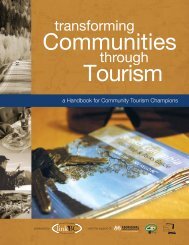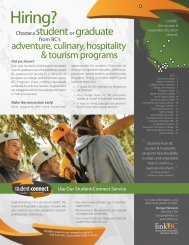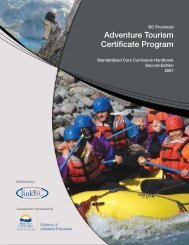Cultural Heritage Tourism Handbook - LinkBC
Cultural Heritage Tourism Handbook - LinkBC
Cultural Heritage Tourism Handbook - LinkBC
- No tags were found...
You also want an ePaper? Increase the reach of your titles
YUMPU automatically turns print PDFs into web optimized ePapers that Google loves.
Position Your Products and ExperiencesDevelop Marketing PartnershipsWhat image or identity do you want to create in the minds of potential visitors? This will shapecustomers’ expectations, creating your ‘position’.Ask your target visitors for their opinion of your destination andindividual attractions, and how they think these stand out from thecompetition. Get testimonials to use in your marketing. Be sure toask how the experience made them feel. The way you describe orwrite about your product will help position your experience.Use Powerful ImagesThe images you use in all marketing collateral should be so strongand compelling that readers/viewers will want to experience youroffer—now!Few tourism businesses or cultural attractions can afford to create in-house marketing campaignsfor all target audiences on their own. Most rely on relationships with partners. Often suppliers andproviders of complementary products and experiences are willing to share marketing costs. Theymay also include your offerings in their marketing initiatives at a reduced cost to you.A Fine ExampleA marketing campaign focusing on a “special place” that evokesan emotional response is at the heart of <strong>Tourism</strong> Newfoundlandand Labrador’s recent tourism campaign. The consumer appeal isaround friendliness, unique culture, cuisine, and dramatically sceniclandscapes that are filled with interesting stories.Choose images based on their power to evoke the feelings oremotions connected with the cultural/heritage tourism experience.Showcase people actively engaged and having fun. Use picturesto convey the sense that this is like nowhere else, and a must-seedestination.When selecting your images, consider:• Are the images a true reflection of the experience you offer?• Do photos capture a moment in time, showing people engagedin something and capturing the spirit of the experience?• Do images feel authentic and real, not posed?• Are people in the photos reflective of your target markets (age,interests, etc.)?• Are your images reflecting your best assets?• Are they all of professional quality? Bad photos are not better thannone at all! Invest time and resources in good images.• Do the images make you want to engage in the experience?• Have you included detailed images of local art?• Are you using high-resolution images, appropriate for the medium?• Do you have permission to use the images, including permissionof people in the images?Don’t forget! The cultural/heritage experience is:Authentic - the real storyQuality - professional presentationUnique - something different78 79










